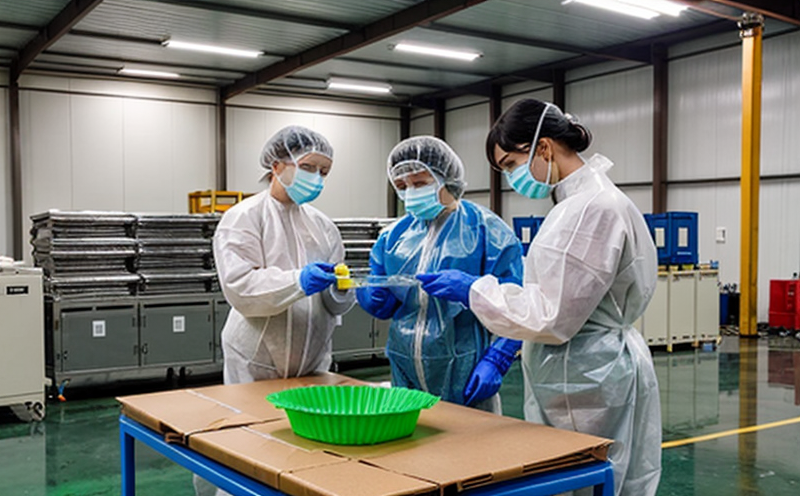ASTM F1249-13 Water Vapor Transmission of Films
The ASTM F1249-13 standard test method is a crucial procedure for evaluating the water vapor transmission rate (WVTR) of plastic films and multilayer structures. This test is essential in ensuring that packaging materials meet specific performance requirements, particularly in environments where moisture ingress can significantly impact product quality.
The ASTM F1249-13 method uses a gravimetric technique to measure the amount of water vapor transmitted through a sample over time under controlled conditions. The test involves placing a known weight of hydrated sodium chloride on one side of a sample and drying it on the other side, allowing water vapor to pass through the film from the wet side to the dry side.
The process is carried out in a constant temperature and relative humidity environment that simulates real-world conditions. This ensures accurate measurement of the material's performance under typical usage scenarios. Understanding the WVTR is vital for packaging design as it helps prevent degradation of products, maintains product integrity, and extends shelf life by protecting contents from moisture.
The ASTM F1249-13 method offers several advantages over other testing methods due to its precision in measuring small amounts of water vapor transfer. This makes it particularly useful for evaluating thin films and multilayer structures where even slight variations in WVTR can significantly impact the performance of the packaging material.
For industries such as pharmaceuticals, food & beverage, and electronics, compliance with this test is mandatory to ensure product safety and quality. The results provide critical data that helps in optimizing packaging design for specific environmental conditions. By adhering to ASTM F1249-13 standards, manufacturers can demonstrate their commitment to quality control and regulatory compliance.
The test method is widely recognized and accepted by regulatory bodies across the globe, making it a cornerstone of industry standards. Compliance with this test ensures that packaging materials meet stringent requirements set forth by various national and international standards organizations.
| Industry Applications | Description |
|---|---|
| Pharmaceuticals | To ensure the integrity of drug products during storage and transport, preventing moisture from compromising product efficacy and safety. |
| Food & Beverage | To protect perishable goods like snacks or dairy products against spoilage due to excessive moisture. |
| Electronics | To safeguard sensitive components inside electronic devices by preventing condensation that can lead to malfunctioning. |
| Bakery Products | To maintain the freshness and texture of baked goods, ensuring they stay moist yet not overly soggy. |
The ASTM F1249-13 test is a critical tool for manufacturers in these industries to ensure their products meet the highest quality standards. By understanding and implementing this test method effectively, companies can enhance product performance, extend shelf life, and improve overall customer satisfaction.
Industry Applications
- Pharmaceuticals: Ensuring drug products remain stable during storage and transport.
- Food & Beverage: Protecting perishable goods from spoilage due to excessive moisture.
- Electronics: Safeguarding sensitive components inside electronic devices by preventing condensation.
- Bakery Products: Maintaining the freshness and texture of baked goods, ensuring they stay moist yet not overly soggy.
Why Choose This Test
- Precision: The ASTM F1249-13 method provides highly accurate measurements of water vapor transmission rates, even for thin films and multilayer structures.
- Regulatory Compliance: Ensures that packaging materials meet stringent requirements set forth by various national and international standards organizations.
- Industry Recognition: Widely recognized and accepted across the globe, making it a cornerstone of industry standards.
- Cost-Effective: By identifying potential issues early in the design process, this test helps reduce costs associated with rework or product recalls.
- Customer Satisfaction: Ensures that products remain safe, effective, and enjoyable for consumers by maintaining proper moisture levels.
- Sustainability: Optimizing packaging to prevent excessive water vapor transfer can lead to reduced material usage and lower overall environmental impact.
- Quality Control: Provides critical data that helps manufacturers optimize packaging design for specific environmental conditions, leading to enhanced product quality.
Quality and Reliability Assurance
The ASTM F1249-13 test is a vital component of the overall quality assurance process. By incorporating this method into their testing protocols, manufacturers can ensure that their packaging materials meet the highest standards for performance and reliability.
To perform the ASTM F1249-13 test accurately, specimens must be prepared carefully to avoid any contamination or damage that could affect the results. Specimens should be cut from the same batch of material and tested under controlled conditions to ensure consistency in results.
The instrumentation used for this testing is highly sophisticated and includes humidity chambers and precision scales. These instruments are calibrated regularly to maintain accuracy and reliability throughout the testing process.
Acceptance criteria for ASTM F1249-13 are based on the specific application of the packaging material. For instance, in pharmaceutical applications, a lower water vapor transmission rate may be preferred to ensure drug stability, while in food & beverage applications, higher rates might be acceptable depending on product type and shelf life.
The results from this test provide critical data that helps manufacturers make informed decisions regarding their packaging design. These insights are essential for optimizing the performance of packaging materials under various environmental conditions.





